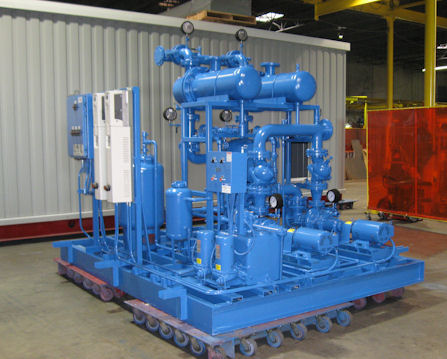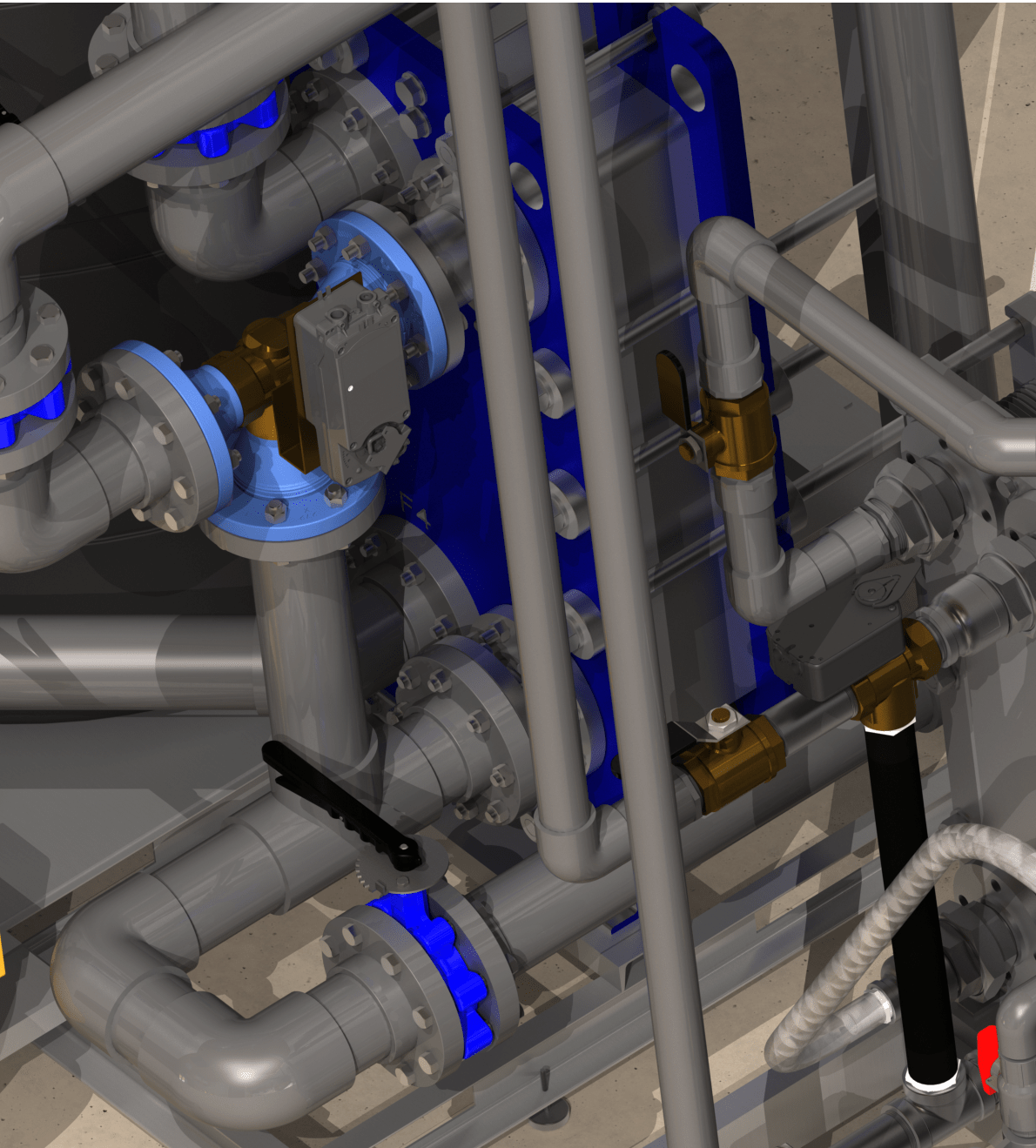How DVS Heat Transfer Systems Use Nanotechnology to Outperform Traditional Cooling Systems
Technologies in Heat Transfer Equipments: What You Required to Know for Optimal Efficiency
Advancements in Heat transfer systems are transforming efficiency throughout various markets. Advanced materials like graphene and nanofluids assure considerable improvements in thermal conductivity. Meanwhile, the combination of IoT and equipment knowing supplies chances for real-time monitoring and improved energy efficiency. Nonetheless, the landscape of thermal management is swiftly evolving (DVS Heat Transfer Systems). Comprehending these developments is necessary for achieving excellent system efficiency and sustainability in the future. What specific innovations are forming this transformation?
Arising Products for Boosted Heat Transfer

Advanced Heat Exchanger Styles
While conventional Heat exchangers have actually served their purpose in various applications, progressed designs are currently arising to fulfill the enhancing demands for effectiveness and efficiency. These ingenious layouts, such as plate, shell-and-tube, and finned-tube Heat exchangers, integrate boosted area and improved flow patterns to raise thermal transfer prices. In addition, small designs enable reduced room demands without endangering effectiveness. Advanced materials, such as compounds and corrosion-resistant alloys, additionally boost sturdiness and performance under extreme problems. Simulation technologies and computational fluid dynamics are progressively employed to refine these styles, guaranteeing peak Heat transfer attributes. As industries look for to lessen energy intake and maximize outcome, the adoption of sophisticated Heat exchanger styles is critical in accomplishing these purposes.
The Duty of Nanotechnology in Heat Transfer
Nanotechnology plays an essential duty in boosting thermal conductivity within Heat transfer systems. By adjusting materials at the nanoscale, scientists have actually achieved substantial improvements in energy effectiveness. These improvements not just enhance efficiency however likewise add to even more lasting power services.
Improved Thermal Conductivity
Significant innovations in thermal conductivity have actually emerged with the application of nanotechnology, transforming Heat transfer systems throughout various sectors. By incorporating nanoparticles into Heat transfer fluids and products, researchers have attained exceptional boosts in thermal conductivity. These nanoparticles, such as carbon nanotubes, graphene, and steel oxides, improve the Heat transfer properties because of their high surface and one-of-a-kind thermal features. The resulting composites exhibit improved efficiency in applications ranging from electronics cooling systems to renewable resource innovations. Moreover, the ability to customize the dimension, form, and make-up of nanoparticles permits for maximized thermal administration remedies. Therefore, nanotechnology remains to play a pivotal role in the growth of much more efficient and efficient Heat transfer systems, leading the method for boosted commercial applications.
Energy Efficiency Improvements

Integration of IoT in Heat Transfer Equipments
The combination of IoT in Heat transfer systems presents the implementation of clever sensors that improve functional efficiency. These sensors enable real-time data surveillance, enabling immediate modifications and optimizations. This technical development has the possible to significantly enhance performance and power management in Heat transfer applications.
Smart Sensors Implementation
As Heat transfer systems evolve, the assimilation of wise sensing units through the Web of Points (IoT) has arised as a transformative strategy. These sensors enable real-time tracking of temperature, stress, and circulation prices, boosting system efficiency and dependability. By collecting and transferring data, they assist in positive upkeep, reducing the danger of system failings. Furthermore, smart sensors add to power financial savings by refining operational specifications based upon environmental problems. Their ability to evaluate patterns and abnormalities permits informed decision-making, guaranteeing peak performance of Heat transfer systems. As sectors significantly embrace this technology, the application of smart sensing units stands to reinvent exactly how Heat transfer systems are taken care of, leading the means for higher sustainability and improved efficiency outcomes.
Real-Time Data Monitoring
Just how can real-time information checking enhance the effectiveness of Heat transfer systems? By incorporating Internet of Points (IoT) technology, Heat transfer systems can take advantage of constant data collection from wise sensing units. This real-time surveillance permits prompt evaluation of pressure, flow, and temperature level rates, allowing operators to recognize inadequacies immediately. As a result, modifications can be made to optimize performance, reduce power intake, and prolong devices life expectancy. Furthermore, anticipating maintenance can be implemented, lessening unanticipated downtime and expensive repair work. The ability to envision efficiency metrics through control panels enhances decision-making, fostering a proactive strategy to system monitoring. Inevitably, real-time information checking not only boosts operational effectiveness yet likewise adds to sustainability objectives within industrial procedures.
Power Efficiency and Sustainability Trends
Power efficiency and sustainability patterns are reshaping the landscape of Heat transfer systems, driving technology and compliance throughout different sectors. Organizations are progressively focusing on energy-efficient layouts to decrease operational expenses and lessen environmental effects. The assimilation of renewable energy resources is coming to be more widespread, making it possible for Heat transfer systems to operate sustainably while fulfilling governing demands. In addition, developments in modern technologies and materials advertise reduced energy consumption and improve general performance. Lifecycle analyses are likewise acquiring grip, allowing companies to examine the environmental influence of Heat transfer systems from manufacturing to disposal. This concentrate on sustainability not just supports business duty yet also placements companies competitively in a market where customers significantly favor green solutions. Energy efficiency and sustainability remain critical considerations for future developments in Heat transfer modern technology.
Advancements in Thermal Administration Solutions
While the demand for my latest blog post efficient Heat transfer proceeds to climb, developments in thermal management solutions are arising to attend to both performance and sustainability challenges. Advanced products, such as phase change products and nanofluids, are being developed to enhance Heat transfer efficiency - DVS Heat Transfer Systems. These materials enhance thermal conductivity and enable better temperature level law in different applications. Furthermore, innovations like active thermal control systems are gaining traction, making it possible for real-time modifications to handle Heat flow effectively. These systems add to energy financial savings and reduce the ecological effect of thermal procedures. Furthermore, the combination of IoT in thermal monitoring helps with tracking and anticipating upkeep, making sure enhanced efficiency and longevity of Heat transfer systems. On the whole, these developments stand for substantial strides toward even more lasting thermal administration techniques
Future Instructions in Heat Transfer Technology
Arising developments in thermal management services signify an appealing future for Heat transfer innovation. Researchers are significantly concentrating on creating materials with remarkable thermal conductivity and boosted energy efficiency. Advancements such as nanofluids, which have suspended nanoparticles, use considerable enhancements in Heat transfer efficiency. Additionally, the integration of clever products that adjust to varying temperature conditions is gaining traction, permitting even more reliable and responsive systems. The surge of additive production methods is likewise allowing the style of complex Heat exchanger geometries that optimize liquid flow. The execution of machine knowing formulas is prepared for to change the optimization of Heat transfer systems, promoting predictive upkeep and efficiency enhancement. Jointly, these innovations are positioned to change the landscape of Heat transfer technologies in various sectors.

Frequently Asked Concerns

Exactly how Do I Select the Right Heat Transfer System for My Application?
Picking the ideal Heat transfer system entails examining application requirements, including temperature arrays, liquid buildings, and effectiveness demands. Assessing system types, maintenance considerations, and cost-effectiveness also plays an important duty in making a notified choice.
What Are the Upkeep Needs for Advanced Heat Exchangers?
Maintenance demands for sophisticated Heat exchangers normally include regular inspections, keeping an eye on for leaks, cleansing of surface areas, and assuring perfect flow rates. Abiding by manufacturer guidelines warranties efficient operation and lengthens the devices's life-span.
How Do Ecological Elements Influence Heat Transfer Efficiency?
Ecological aspects significantly influence Heat transfer effectiveness. Variants in humidity, temperature, and air movement effect thermal conductivity and convective Heat transfer, ultimately influencing system performance and necessitating factor to consider throughout the style and operation of Heat transfer systems.
What Safety And Security Requirements Apply to Heat Transfer Solutions?
Safety and security requirements for Heat transfer systems usually include guidelines from organizations such as ASME and ASTM. DVS Heat Transfer Systems. These criteria address materials, style, and operational techniques to guarantee dependability, efficiency, and protection against risks in different applications
Exactly How Can I Troubleshoot Typical Heat Transfer System Issues?
Repairing typical Heat transfer system issues involves inspecting for leaks, making certain proper liquid circulation, inspecting insulation stability, and confirming temperature differentials. Identifying these elements can aid preserve system effectiveness and prevent further issues.
Nanotechnology plays a necessary role in boosting thermal conductivity within Heat transfer systems. Substantial innovations in thermal conductivity have actually emerged via the application of nanotechnology, transforming Heat transfer systems across numerous industries. Innovations in thermal conductivity with nanotechnology have led the means for exceptional improvements in power effectiveness within Heat transfer systems. Energy effectiveness and sustainability patterns are reshaping the landscape of Heat transfer systems, driving you can find out more technology and conformity throughout various industries. The combination of IoT in thermal management promotes monitoring and predictive maintenance, ensuring enhanced efficiency and durability of Heat transfer systems.